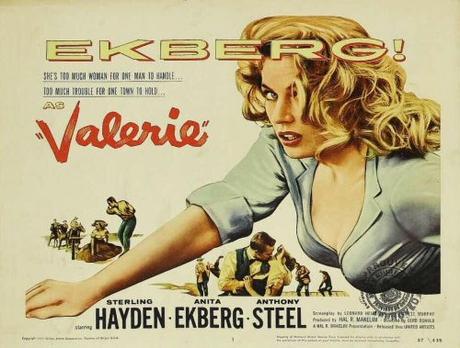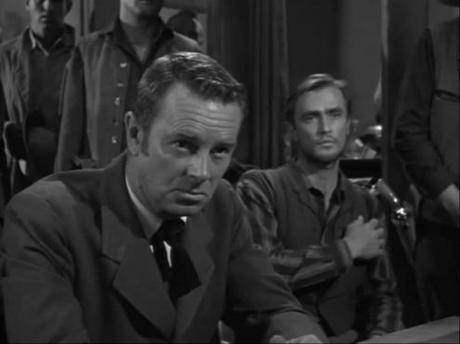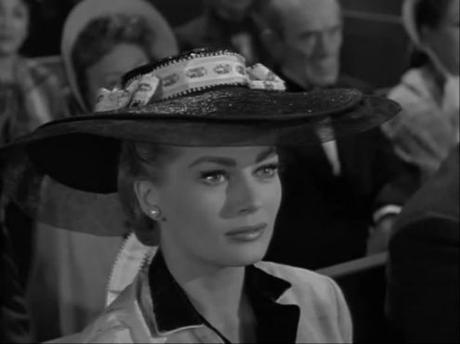
Perspectives and perceptions, views and understanding, the way we see events and how we process what's seen. This is the basis of Gerd Oswald's Valerie (1957), a western which serves up a set of circumstances and then challenges us to interpret them correctly. The art of the filmmaker is frequently dependent on the successful placement of the camera, the mise-en-scène that draws the eye this way and that and coaxes a reaction or nudges us towards a conclusion. In short, there is a degree of manipulation involved, or to put it less provocatively an encouragement of certain approaches. Ultimately though, if the filmmaker is to retain any integrity, it is incumbent on them to seek the truth. Valerie takes a handful of typical western themes - the nature of heroism and the concepts of opportunity and equality - and proceeds to filter them through the prism of a number of perspectives, bending and splitting them according to the perceptions of the individual narrator before finally arriving at the irrefutable truth.
The film begins with a killing, although the act itself is not seen (not at this point at any rate) and only the bloody consequences are presented to us. John Garth (Sterling Hayden), a wealthy rancher, approaches and enters the home later revealed to be that of his in-laws, a volley of gunshots is heard and then he exits allowing the audience to peek through the doorway at the carnage left behind. Among the torn bodies strewn across the parlor floor is the figure of Valerie (Anita Ekberg), Garth's estranged wife. The story then shifts to the court where Garth finds himself on trial, his lawyer claiming self-defense while the prosecution alleges murder. The truth lies in the past, a past revealed over the course of the next hour or so via flashbacks resulting from the testimony of the witnesses and the defendant. What follows is a tale of love and jealousy, of mistrust and suspicion, culminating in abuse, violence and death. The telling and retelling of what led up to the tragedy and bloodshed could easily become tedious but the altered perspectives which uncover additional pieces of information as well as allowing different interpretations to form ensure it remains absorbing right up to the end, to that point where the full truth is laid bare and everything is made clear.

Director Gerd Oswald was an immigrant himself and perhaps that adds an extra layer to the aspect of the story which focuses on the outsider attempting to fit into new surroundings. Ekberg's Valerie is shown as the exotic object of desire as well as the potentially untrustworthy interloper, a figure simultaneously representing attraction and repulsion to Garth's native son. This highlights the essential weakness and vulnerability of her position, and by extension that of the immigrant in general, where her word is always likely to be regarded as suspect when set against that of the stolid familiarity which her husband embodies. There is too if not exactly an enthusiasm then at least a willingness to believe in some latent wantonness and loose morality in such an outsider, something reinforced by her apparent closeness to the local preacher (Anthony Steel) who also happens to be an immigrant. This subversion of the notion of the old west as a land of boundless freedom and opportunity is neatly done.
If the movie can be seen to be scratching at the mythology of the old west, it's also following the path of many a 1950s melodrama by casting an unflinching glance at some of society's most unassailable pillars. The idea of the hero, particularly that of the war hero, is a powerful one. It brings to mind images of selflessness and honor, something fine and upstanding. And so we come back to perception - Garth is celebrated and lauded as a war hero, a man who has served with distinction. Yet it's slowly revealed that his role was a murkier one, he was by his own admission a de facto torturer whose job was to extract information from prisoners by whatever means were available. Are we to perceive the violence Garth is capable of as an inherent character flaw or as an indictment of the brutalizing effect of war? Garth's cruelty is not in question, only the underlying reasons are left to the discretion of the viewer.

Anita Ekberg and the Trevi Fountain sequence in Fellini's La Dolce Vita are inextricably linked in my mind and I suspect that will be the case with many others, it's one of those cinematic images that is universally recognizable. From what I've seen of her Hollywood career it could best be described as variable but there are still a few gaps I need to fill in and I really need to catch up with John Farrow's Back from Eternity some time soon. For the most part she was fine as Valerie, although the moments where she was called upon to emphasize the "bad girl" side of the character are less successful than those where she is being victimized. Hayden's physical presence is used to excellent effect and he generally turns in a strong performance, communicating the threatening and intimidating nature of his character most convincingly. The bluntness, the abruptness and the raw implacability of the man are unmistakable every time he pads menacingly into the frame. Those two dominate the movie throughout, although Anthony Steel (Ekberg's husband at the time) has a sympathetic albeit frequently ineffectual role as the preacher who is drawn to the troubled Valerie. While he appears slight next to Hayden's brooding massiveness he also brings a sense of calm and culture, providing something of a counterweight to the simmering passions all around him.
Valerie was released on DVD in the US by MGM years ago and I think it turns up online regularly too. It looks like an open matte transfer as there is generally some empty space at the top of the screen visible, but that's not a major issue and the image is satisfyingly sharp and clean. This is not a film that gets mentioned very often, even among film fans, and I feel it is worthy of a bit more attention. It offers a different spin on the traditional western, blending in melodrama, courtroom suspense and some frank yet unobtrusive social commentary. All in all, it offers a satisfying hour and twenty minutes of viewing and there's the added benefit that it throws in a little food for thought. My advice is to keep an eye out for it.
